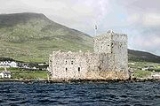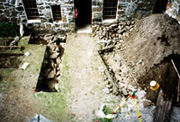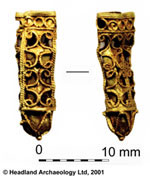
Kisimul Castle
Encyclopedia
Kisimul Castle is a small medieval castle
located in the centre of Castlebay
on Barra
, an island
of the Outer Hebrides
, Scotland
.
Kisimul (or Chisimul) Castle gets its name from the Gaelic
words cìs (tax) and mul (mound) meaning "The place where taxes are paid".
Kisimul sits on a rocky islet in the bay just off the coast of Barra, and as it is completely surrounded by the sea; it can only be reached by boat making the fortification impregnable. Kisimul has its own fresh water wells. Legend has it that this has been the stronghold of the MacNeils since the 11th century.
Kisimul was abandoned in 1838 when the island was sold, and the castle's condition deteriorated. Some of its stone
was used as ballast for fishing vessels, and some even ended up as paving
in Glasgow
. The remains of the castle, along with most of the island of Barra, were purchased by the chief of Clan MacNeill in 1937, who made efforts at restoration.
In 2001 the castle was leased by the chief of Clan MacNeil
to Historic Scotland
for 1000 years for the annual sum of £
1 and a bottle of whisky
.
 Archaeological investigations were carried out at Kisimul Castle by Headland Archaeology
Archaeological investigations were carried out at Kisimul Castle by Headland Archaeology
, on behalf of Historic Scotland. This involved some excavation, building recording and archival research. It was hoped that the project would help clarify the date of the castle and its sequence of construction. Another aim was to establish whether or not the island had been occupied before construction of the castle.
 Excavation concentrated on areas of the courtyard, the basement of the tower and the bottom of a pit prison. At the east end of the courtyard there was a great deal of building rubble directly below the surface, some of which had mortar attached. This suggested that an earlier building had been demolished or collapsed, and the stone used to form a level courtyard. This happened before the building known as the kitchen was built. At the other end of the site a stone drain leading under the great hall was uncovered together with a paved stone surface. Above these was a layer containing large amounts of animal bone, shell and pottery. There were also floor surfaces within buildings that had been demolished.
Excavation concentrated on areas of the courtyard, the basement of the tower and the bottom of a pit prison. At the east end of the courtyard there was a great deal of building rubble directly below the surface, some of which had mortar attached. This suggested that an earlier building had been demolished or collapsed, and the stone used to form a level courtyard. This happened before the building known as the kitchen was built. At the other end of the site a stone drain leading under the great hall was uncovered together with a paved stone surface. Above these was a layer containing large amounts of animal bone, shell and pottery. There were also floor surfaces within buildings that had been demolished.
During the excavation many finds were recovered. These included large quantities of animal bone and shell. Further study of these will allow us to discover more about the diet of those who lived in the castle. A large quantity of broken pottery was also found and appears to range in date from prehistoric times through the medieval period to the more recent past. A number of pieces of flint were recovered including a particularly fine flint blade. These tools together with some of the pottery show that people were using the island thousands of years before the present castle was built.
The most exciting find was recovered from one of the trenches dug within the tower. It is a fine, small gold object, shown here and in almost perfect condition. This is being looked at by specialists to discover its age and function.
Castle
A castle is a type of fortified structure built in Europe and the Middle East during the Middle Ages by European nobility. Scholars debate the scope of the word castle, but usually consider it to be the private fortified residence of a lord or noble...
located in the centre of Castlebay
Castlebay
Castlebay is the main village and a community council area on the island of Barra in the Outer Hebrides of Scotland. It is located on the south coast of the island, and overlooks a bay in the Atlantic Ocean dominated by Kisimul Castle, as well as nearby islands such as Vatersay.- Church :The...
on Barra
Barra
The island of Barra is a predominantly Gaelic-speaking island, and apart from the adjacent island of Vatersay, to which it is connected by a causeway, is the southernmost inhabited island of the Outer Hebrides in Scotland.-Geography:The 2001 census showed that the resident population was 1,078...
, an island
Island
An island or isle is any piece of sub-continental land that is surrounded by water. Very small islands such as emergent land features on atolls can be called islets, cays or keys. An island in a river or lake may be called an eyot , or holm...
of the Outer Hebrides
Outer Hebrides
The Outer Hebrides also known as the Western Isles and the Long Island, is an island chain off the west coast of Scotland. The islands are geographically contiguous with Comhairle nan Eilean Siar, one of the 32 unitary council areas of Scotland...
, Scotland
Scotland
Scotland is a country that is part of the United Kingdom. Occupying the northern third of the island of Great Britain, it shares a border with England to the south and is bounded by the North Sea to the east, the Atlantic Ocean to the north and west, and the North Channel and Irish Sea to the...
.
Kisimul (or Chisimul) Castle gets its name from the Gaelic
Scottish Gaelic language
Scottish Gaelic is a Celtic language native to Scotland. A member of the Goidelic branch of the Celtic languages, Scottish Gaelic, like Modern Irish and Manx, developed out of Middle Irish, and thus descends ultimately from Primitive Irish....
words cìs (tax) and mul (mound) meaning "The place where taxes are paid".
History
The earliest documentary record of Kisimul Castle dates from the mid 16th century.Kisimul sits on a rocky islet in the bay just off the coast of Barra, and as it is completely surrounded by the sea; it can only be reached by boat making the fortification impregnable. Kisimul has its own fresh water wells. Legend has it that this has been the stronghold of the MacNeils since the 11th century.
Kisimul was abandoned in 1838 when the island was sold, and the castle's condition deteriorated. Some of its stone
Rock (geology)
In geology, rock or stone is a naturally occurring solid aggregate of minerals and/or mineraloids.The Earth's outer solid layer, the lithosphere, is made of rock. In general rocks are of three types, namely, igneous, sedimentary, and metamorphic...
was used as ballast for fishing vessels, and some even ended up as paving
Sidewalk
A sidewalk, or pavement, footpath, footway, and sometimes platform, is a path along the side of a road. A sidewalk may accommodate moderate changes in grade and is normally separated from the vehicular section by a curb...
in Glasgow
Glasgow
Glasgow is the largest city in Scotland and third most populous in the United Kingdom. The city is situated on the River Clyde in the country's west central lowlands...
. The remains of the castle, along with most of the island of Barra, were purchased by the chief of Clan MacNeill in 1937, who made efforts at restoration.
In 2001 the castle was leased by the chief of Clan MacNeil
Clan MacNeil
Clan MacNeil, also known in Scotland as Clan Niall, is a highland Scottish clan, particularly associated with the Outer Hebridean island of Barra. The early history of Clan MacNeil is obscure, however despite this the clan claims to descend from the legendary Niall of the nine hostages...
to Historic Scotland
Historic Scotland
Historic Scotland is an executive agency of the Scottish Government, responsible for historic monuments in Scotland.-Role:As its website states:...
for 1000 years for the annual sum of £
Pound sterling
The pound sterling , commonly called the pound, is the official currency of the United Kingdom, its Crown Dependencies and the British Overseas Territories of South Georgia and the South Sandwich Islands, British Antarctic Territory and Tristan da Cunha. It is subdivided into 100 pence...
1 and a bottle of whisky
Whisky
Whisky or whiskey is a type of distilled alcoholic beverage made from fermented grain mash. Different grains are used for different varieties, including barley, malted barley, rye, malted rye, wheat, and corn...
.
Archaeological survey

Headland Archaeology
Headland Archaeology comprises a holding company Headland Group Ltd and the trading subsidiaries Headland Archaeology Ltd, Headland Archaeology Ltd and Archaeological Investigations Ltd....
, on behalf of Historic Scotland. This involved some excavation, building recording and archival research. It was hoped that the project would help clarify the date of the castle and its sequence of construction. Another aim was to establish whether or not the island had been occupied before construction of the castle.

During the excavation many finds were recovered. These included large quantities of animal bone and shell. Further study of these will allow us to discover more about the diet of those who lived in the castle. A large quantity of broken pottery was also found and appears to range in date from prehistoric times through the medieval period to the more recent past. A number of pieces of flint were recovered including a particularly fine flint blade. These tools together with some of the pottery show that people were using the island thousands of years before the present castle was built.
The most exciting find was recovered from one of the trenches dug within the tower. It is a fine, small gold object, shown here and in almost perfect condition. This is being looked at by specialists to discover its age and function.

